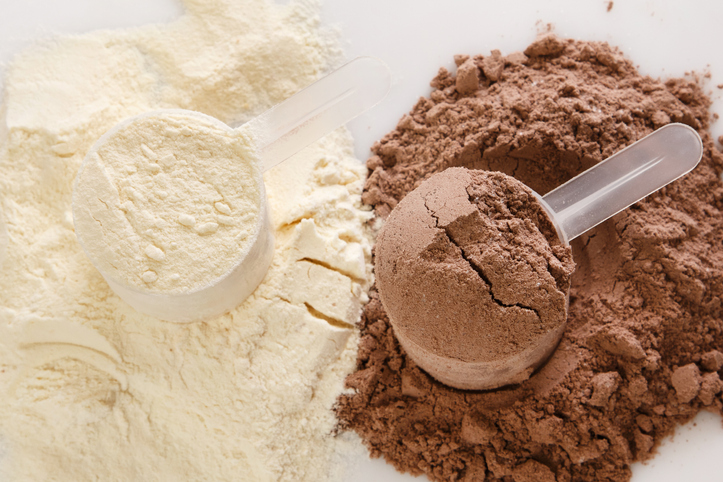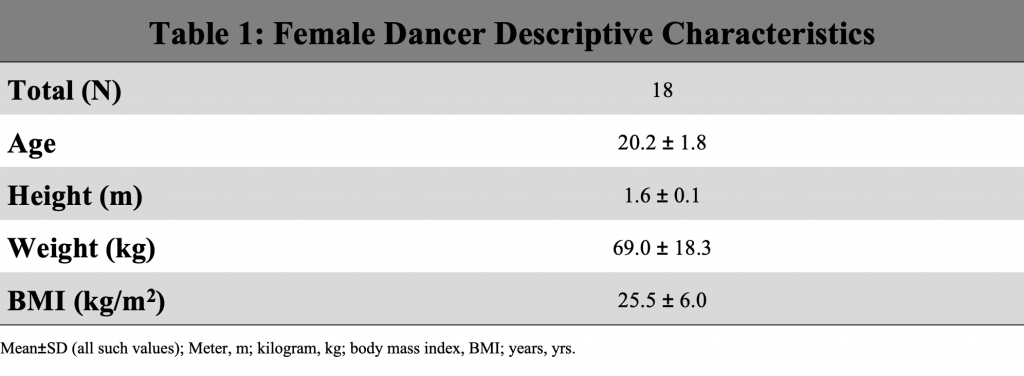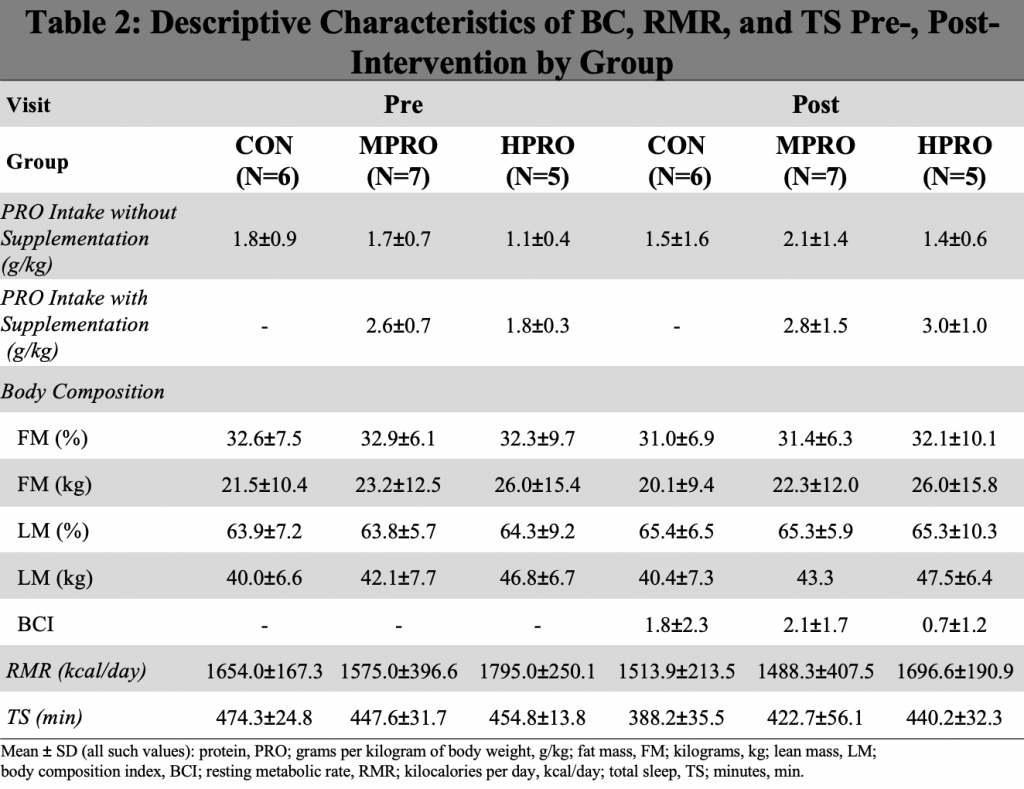
Differences in Body Composition, Resting Metabolic Rate, and Sleep Quality Following a 6-Week Protein Supplementation Intervention in Collegiate Dancers
By: Hannah Bideganeta Email: bide4149@vandals.uidaho.edu
Home Town: Mountain Home, ID High School: Mountain Home High School
Major: Exer, Sprt, Hlth Sci-Pre-PT
Department: Movement Sciences
College: College of Education, Health and Human Sciences
Abstract
Dancers are often under pressure to maintain a lean physique; therefore it is common to observe unhealthy dieting behaviors leading to inadequate caloric intake and protein (PRO), which may negatively alter body composition (BC). PURPOSE: To assess collegiate dancers’ dietary intake, BC, resting metabolic rate (RMR), and total sleep (TS) following a 6-week PRO intervention. METHODS: Dancers (N = 18; ages 20.2±1.8yrs), were randomly assigned to a control (CON; N=6), moderate PRO (MPRO; N=7; 40g/d), or high PRO group (HPRO; N=5; 90g/d). Diet was assessed using 24-hour recall. BC, RMR, and TS were assessed pre and post intervention. BC index (BCI=(LMpost-LMpre)+(FMpre-FMpost)) was used to assess BC changes. Statistical analyses were completed using SPSS Statistics (v.24), data were reported as mean±SD, and significance was accepted at p<0.05. RESULTS: BCI was positive for all groups, (CON:1.8±2.3, MPRO: 2.1±2.7, HPRO 0.7±1.2), MPRO being the most positive. RMR decreased from pre to post testing (CON: -140.1±108.8 kcal/day; MPRO: -86.8±144.5 kcal/day; HPRO: -98.4±95.5 kcal/day), with CON significant at p=0.045. TS also decreased from pre to post testing (CON: -85.3±39.0min; MPRO: -24.9±42.1min; HPRO: -14.6±24.7min) with CON significant at p=0.003. CONCLUSION: The PRO intervention showed overall positive BC changes among all three groups. BCI indicates that MPRO had more positive BC changes than CON and HPRO which indicates that high PRO consumption is not necessary to see improvements in BC.
Introduction
Aesthetic sports such as gymnastics, dance, swimming and figure skating place a high demand on athletes to maintain a lean physique. The evaluation of successful performance in these sports is based on competence in performing elements as well as visual aesthetic impressions, to which body shape contributes immensely 1,2. The demand to maintain a lean physique may be influenced by perceiving improvements in BC are related to athletic performance 3–5. In addition to high demand for a lean physique, athletes participating in aesthetic sports may also feel an increased pressure to reduce body weight, despite being within a healthy weight range 6,7. Emphasis on leanness often presents itself as severe caloric restriction 2,7. In order to maintain LM, which is important for physique, athletes must consume adequate PRO 8. In a study focused on female collegiate dancers, researchers demonstrated only 16% percent of participants consumed the recommended amount of dietary PRO for maintaining LM in an athletic population striving to maintain low body mass9. Additionally, LM is a large contributing factor to RMR, accounting for approximately 60 to 70%, therefore an increase in LM contributes to increases in RMR 10. Furthermore, sleep has numerous imperative physiological and cognitive functions and is crucial to athletic performance 11–13. Recent evidence demonstrates that athletes may experience reduced quality and/or quantity of sleep due to training schedules 11. Studies among non-aesthetic athletes and gymnasts have demonstrated athletes struggle to achieve high quality and long durations of sleep as well as maintain a consistent sleep schedule11,13. Sleep is important not only for athletic performance, but also for success in other aspects of life. College is an especially busy time for students and dance majors struggle to obtain sufficient sleep which can take a toll on health and wellbeing. Understanding the effects of PRO intake on BC, RMR and sleep can aid in the prevention and reduction of medical complications in aesthetic sports.
Methods
PARTICIPANTS: Eighteen female collegiate dancers (ages 20.2±1.8 yrs) were recruited from the University of Idaho Dance Program. Eligible subjects included individuals enrolled in the University of Idaho dance program as a major or minor, free of any injuries that would prevent participation for 2 weeks or more, and non-smokers. The University of Idaho IRB approved all requirements and procedures.
DATA COLLECTION: Participants were randomly assigned to a control (CON; n=6), moderate PRO (MPRO; n=7; 40g/d), or high PRO group (HPRO; n=5; 90g/d). Diet was assessed using 24-hour recall. BC, RMR, and TS were assessed pre and post intervention. BC index (BCI=(LMpost-LMpre)+(FMpre-FMpost)) was used to assess BC changes. Height and weight were measured using a stadiometer (SECA 216, Hamburg, Germany) and a digital scale (DETECTO, Model 6127, Webb City, MO). Dual-energy x-ray absorptiometry scan (DXA) was used to assess FM and LM (DXA; Hologic Inc., Discovery QDR Series, Bedford, MA, USA). RMR was measured and recorded using the ParvoMedics TrueOne 2400 metabolic cart. Participant’s TS was assessed using ŌURA Rings (Oulu, Finland).
STATISTICAL ANALYSIS: SPSS Statistics was used to complete statistical data analysis. Data were reported as mean±SD and significance was accepted at p<0.05. Paired t-test was used to compare groups.
Results


Discussion
All groups experienced a decrease in FM and an increase in LM percentage. CON experienced the most significant average increase in LM and average decrease in FM, while MPRO experienced a similar increase and decrease in LM and FM, respectively. Both CON and MPRO experienced overall better BC outcomes than HPRO, which observed the lowest increase in LM and decrease in FM. BCI shows that overall, MPRO had the most positive BC changes throughout all groups and HPRO had the least positive changes in BC. Observations of BCI show that high PRO intake is not necessary to see improvements in BC. All groups experienced decreases in RMR, with CON being the most significant. Both PRO groups could likely have seen increased LM maintenance, which would reduce decreases in RMR, due to LM being the most metabolically active tissue in the body. Throughout all three groups, decreases in RMR could also be due to decreases in body weight throughout all groups. As the study progressed, total sleep decreased among all groups. This is likely due to the advancement of the academic calendar, and subsequent increased course load and dance practice requirements, as the study progressed.
References
1. Misigoj-Durakovic M, Vucetic V, Durakovic Z, et al. Body physique and composition in premenarchal ballerinas and female athletes in aesthetic sports. Med Probl Perform Art. 2005.
2. Sundgot-Borgen J, Garthe I. Elite athletes in aesthetic and Olympic weight-class sports and the challenge of body weight and body composition. J Sports Sci. 2011. doi:10.1080/02640414.2011.565783
3. Krentz EM, Warschburger P. Sports-related correlates of disordered eating in aesthetic sports. Psychol Sport Exerc. 2011. doi:10.1016/j.psychsport.2011.03.004
4. La Bounty P, Antonio J. Energy Expenditure and Body Composition. In: Campbell B, Spano MA, eds. NSCA’s Guide to Sport and Exercise Nutrition. ; 2011:183.
5. Sundgot-Borgen J, Meyer NL, Lohman TG, et al. How to minimise the health risks to athletes who compete in weight-sensitive sports review and position statement on behalf of the Ad Hoc Research Working Group on Body Composition, Health and Performance, under the auspices of the IOC Medical Commission. Br J Sports Med. 2013. doi:10.1136/bjsports-2013-092966
6. de Bruin AP (Karin., Oudejans RRD, Bakker FC. Dieting and body image in aesthetic sports: A comparison of Dutch female gymnasts and non-aesthetic sport participants. Psychol Sport Exerc. 2007. doi:10.1016/j.psychsport.2006.10.002
7. Dwyer J, Eisenberg A, Prelack K, Song WO, Sonneville K, Ziegler P. Eating attitudes and food intakes of elite adolescent female figure skaters: A cross sectional study. J Int Soc Sports Nutr. 2012. doi:10.1186/1550-2783-9-53
8. American Dietetic Association, Dietitians of Canada, American College of Sports Medicine, Rodriguez NR, Di Marco NM, Langley S. American College of Sports Medicine position stand. Nutrition and athletic performance. Med Sci Sports Exerc. 2009. doi:10.1249/MSS.0b013e31890eb86
9. Ann Frost Brown, Christopher William Bach, Giuliana De Almeida, Shawn Leonard, Tom Welsh, Michael James Ormsbee. Body Composition and Performance Capabilities Based on Protein Intake in Collegiate Dancers: A Pilot Study. J Sport Sci. 2017. doi:10.17265/2332-7839/2017.04.001
10. Blundell JE, Caudwell P, Gibbons C, et al. Role of resting metabolic rate and energy expenditure in hunger and appetite control: A new formulation. DMM Dis Model Mech. 2012. doi:10.1242/dmm.009837
11. Sargent C, Lastella M, Halson SL, Roach GD. The impact of training schedules on the sleep and fatigue of elite athletes. In: Chronobiology International. ; 2014. doi:10.3109/07420528.2014.957306
12. Halson SL. Sleep in elite athletes and nutritional interventions to enhance sleep. Sport Med. 2014. doi:10.1007/s40279-014-0147-0
13. Silva MRG, Silva HH, Paiva T. Sleep duration, body composition, dietary profile and eating behaviours among children and adolescents: a comparison between Portuguese acrobatic gymnasts. Eur J Pediatr. 2018. doi:10.1007/s00431-018-3124-z

